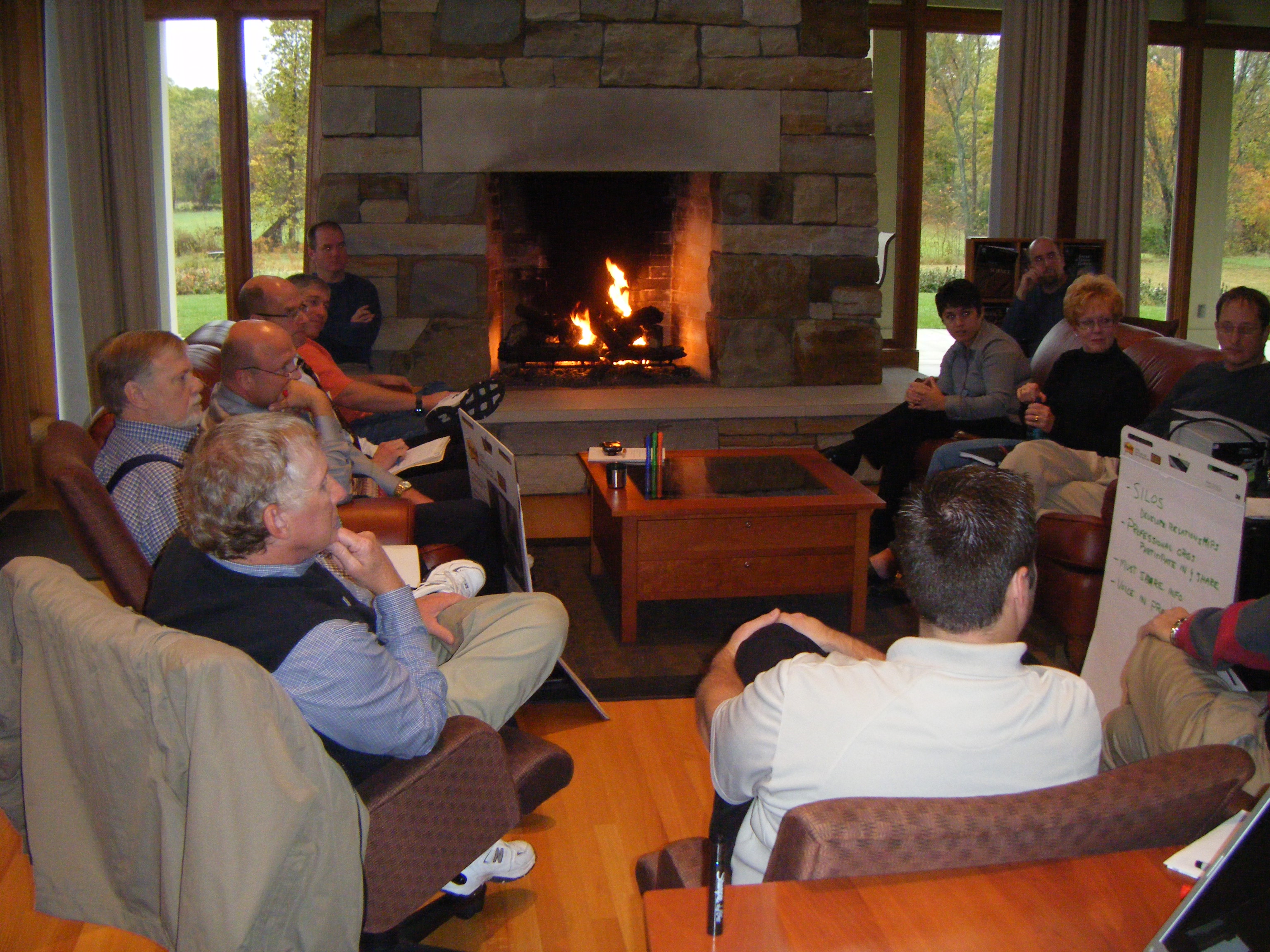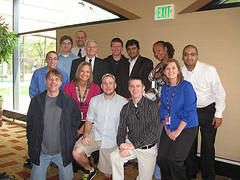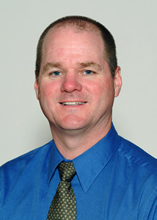Key Takeaways
- Despite an economic slump, an academic structure in flux, proliferation of technology, and heightened competition for grants, a new model for provisioning IT in the new normal can enable institutions of higher ed to provide more resources, more efficiently and effectively.
- We can improve the economics of IT in higher ed by building partnerships and leveraging existing IT resources in new ways and across institutional boundaries.
- Adopting a new model now positions us for increasing innovation, for extending the kinds of partnerships we see in such community source initiatives as Sakai and Kuali, and for collectively designing the model for future scholarship.
Back in the early '90s our boss handed out Sun Tzu's The Art of War.1 This year's book was Stephen Covey's The Speed of Trust: The One Thing That Changes Everything.2 How did we get from war to trust?
In the '90s IT was in control. The "war" was about winning over the Indiana University community, encouraging schools and departments to accept responsibility for local services, and getting our users to adopt recommended tools. Today, by contrast, IT is pervasive, and local support services have proliferated, so much so that they are duplicated in schools and departments across the campus. This is also a time of great uncertainty. The economy is flat; higher ed is in flux. How should we visualize our future role?
We can view uncertainty on this scale as a threat or as an opportunity. Flux and change make room for innovation. This is the time to ask, Who should be at the controls, IT or the community? How about a partnership of IT and the community? The technology is ready to support a new model of partnership: IT and the community working together to leverage our combined resources, eliminate duplication, and remain poised for innovation.
Indiana University is putting in place such a model, which we call Edge, Leverage, and Trust, or ELT. ELT has to potential to:
- Enable higher ed to leverage IT resources efficiently and effectively.
- Increase opportunity for IT innovation without additional resources.
- Position IT for continued evolution and partnership beyond institutional walls.
For a discussion of some early benefits of the ELT model, moderated by IU IT VP and CIO Brad Wheeler, see the 2009 IU Statewide IT Conference panel, "IT Issues: Leverage, Edge, and Trust."
The process of structuring this model at IU is still under way; it is too early for an overall measure of success. Yet already we've seen benefits, simply in the process of laying the foundation. Among them:
- Closer relationships with our client communities that result in richer data about needs and concerns, which help us more accurately target audiences and define appropriate services
- Viewing the university's IT resources as one
- Groups of people working together across institutional boundaries to find solutions
- Greater brainpower applied to finding IT solutions, including leveraging current resources for greater value, and involving new technologies
- Growth of a trust environment within central IT and between IT and the university.
ELT: The Basics
ELT takes a holistic view of IT resources across the university to find the most efficient and effective way to do things. The constant in this model is leverage. Leverage is eminently practical — it finds the most pragmatic way of getting something done. At IU, ELT crosses the boundaries between IT and the university to blend IT staff in schools and departments at the edge with staff at the center. Innovations and expertise flow from the edge to the center, and from the center to the edge. The result is more resources for everyone.
ELT can be disruptive. It introduces disruptive technologies like virtualization. It may require reconfiguring parts of the organizational structure and mixing IT staff together in new ways. While change is part of the IT milieu, change on this order can breed reluctance or fear in those who want to hang onto their niche and cry "Mine!"3
This is where trust comes in. Trust is the ideal mindset in the partnerships that will achieve shared goals. Trust keeps in motion the dynamic cycle of edge and leverage needed to deliver the common and the innovative in today's complex IT environment (see Figure 1).

Figure 1. The ELT Model
ELT and Economy
When academe suffered major losses of revenue, demand for IT resources did not decline. Instead, academe needed IT as never before. Where once IT enabled academe, today the two are tightly bound in what Michael McRobbie and Brad Wheeler call a "recursive relationship. IT also reshapes the very conduct of research and education."4 There's another factor. The financial crisis stiffened competition for resources like grant funding and awards, which meant central IT had to be quicker and more agile in providing new resources.
Is today's "distributed" model up to the job? Can we afford it? Distributed computing was a response to the '90s spike in PC ownership, when some schools and departments hired their own IT staff to augment the central IT services. But is supporting one department really that different from supporting another? How many instances of local staff upgrading operating systems do we need? Even if we could write the check, expanding today's distributed model won't scale. Instead, if we trim duplication and virtualize repeat services, we can recoup some costs and apply those "found" assets to strategies for meeting new demands today and innovating for the future.
Think about software. How much goes unused? When we need an application, we usually buy it for a specific workstation or FTE. Say that close to 100 applications are installed on your laptop. If you're writing an article and occasionally checking e-mail, how many apps are sitting idle? The practical solution is a common administration, common storage, and common apps for the common functions. Emerging technology may enable virtualized endpoints, open the door to leveraged software licensing, and improve security.
ELT and Building Trust
Bringing ELT into the IT environment at IU involved organizational, functional, and cultural changes, in central IT and the university, and between the two. Trust is key: ELT is as much about people and the culture as it is about technology. Turning a culture around is no easier than changing a ship's course. You do it with one eye turned inward and the other on the horizon. Introducing change on this scale requires trust between IT and the university, and within IT itself.
What is the trust rating on your campus? Annual survey results, community feedback, and anecdotal data tell us a lot. We know campus trust takes a hit when we install new systems without first addressing the issues most important to users. When technology hinders productivity, we're seen as "doing things" to people. And if our decision making seems to be driven by the latest technology alone, we may come across as a remote, secretive bureaucracy. It takes at least as much effort to rebuild trust, maybe more, than to create it in the first place.
Know the Basics
Where do you begin? Strategies for building trust may vary, but some principles are universal. We create trust day by day. Consistency is key; a small misstep can undo a lot of progress. Trust is about one thing: relationships, relationships, relationships. Building relationships of trust requires consistent, positive action, collectively and individually, over a period of time. Define a strategy for building trust and support it however possible.
Make trust an organizational value and priority. In every interaction, each IT professional is the face of central IT. Communication, presentations, and workshops on trust can help staff become trust ambassadors, in central IT and on the campus.
Find ways amid the daily crunch to reach out. Don't know where to start? Invite someone to lunch. (Lunch is the fallback at IU.) It took us two years of frank discussions over food to feel the beginnings of real trust outside central IT.
Make a Plan
To build trust, advance ELT, and address strategic IT goals, we launched a series of initiatives that focused on various segments of the IU community. These audiences form concentric circles, from broad and external to internal within central IT. In retrospect, moving from broad to specific increased our odds of reaching key partners. We involved these audiences more or less concurrently in initiatives of interest to them.
The initiatives, described below, focused on these audiences:
- The university at large, especially faculty and staff
- IT peers at the edge
- Central IT
- Students
The University
Empowering People, IU's second strategic plan for university IT, set out to maximize the efficiency and productivity of the community. University Information Technology Services (UITS) took the strategic step of inviting the community to partner with us in developing the plan. Then we proposed that a faculty member — not central IT — lead the process. A professor led committees of faculty, staff, students, and IT staff in conceiving a technology environment to support IU's work. The committees sought the experience, suggestions, brainpower, and judgment of their colleagues. IT and planners got out on campus, speaking about Empowering People, answering questions, and gathering input. One listener spoke to another, who told another, and soon self-sustaining networks drew more people into the planning, feedback, and review processes.
Not all beginnings will have this high a profile. But in retrospect, the strategic planning process (see "Empowering People") made a powerful, public declaration of partnership between UITS and the university and set the groundwork for future shared initiatives.
IT Peers
Among IT peers, we emphasize that becoming efficient and effective at provisioning the new normal will take the collective brainpower, experience, and expertise of IT staff at the center and the edge, working as a unified team. How do we build enough trust that they become willing members of that team? How do we move from a paper org chart to functional reality when the staff on the edge is almost as large as the central staff — and doesn't report to us? Make clear their value to the team.
Staff at the edge offer unique expertise. They have worked side-by-side with innovators and researchers who, for example, developed discipline-specific software or designed a local application for managing data. For some IT organizations, this brainpower may be an untapped resource. On the edge, the "potential for innovation and growth is the highest … where unmet needs intersect with unexploited capabilities."5 Weaving this constituency into the organization can help create a holistic system that provides new areas of special expertise across the university. At IU, IT staff at the edge were vigorous proponents of virtualization; through their advocacy and expertise UITS recognized its value. Edge staff now lead the university's virtualization initiative. Director of Information Technology Charles A. McClary, Division of Recreational Sports, and one of the original members of the IT Managers Council commented:
With their eyes on the horizon, edge staff can help map our future trajectories. As a place of innovation and growth, the edge can serve IT as a bellwether, offering cues to what's coming. According to John Hagel III and John Seely Brown, ". . .[U]nless you go frequently to the edge you won't see what's coming at you, and you'll miss both opportunities and threats."6
Central IT
Building trust takes place on intellectual and personal levels, so help people understand the context of the changed directions. Creating a shared intellectual understanding is an act of collegiality, and it opens the door for questions. It's always surprising how easily unasked questions can morph into unspoken anxieties that then undermine trust. Help staff fit themselves into context: map their new roles to strategic directions, and the university's direction to wider shifts in academic IT. At IU, we've made ELT an organizational value, intrinsic to the content and spirit of Empowering People. Our new direction of partnership is also a local expression of such broader cultural shifts as "open" and community source.
But it's not enough to discuss "Why ELT now?" and the ELT philosophy and strategy. People want the bottom line: How does this affect my job? Some will feel threatened; some will worry they're being marginalized, or worse, that their jobs will be eliminated. Address rumors and be transparent. Stress the bottom line: This is about doing things with the utmost efficiency. Combining forces and adopting new technologies like virtualization can bring more opportunities to innovate. Staff involved in creating solutions will likely feel valued and empowered.
Creating new, blended teams is its own challenge, but structuring opportunities for frequent personal contact can shorten the "them-versus-us" phase. One new relationship of trust can be the catalyst for an entire team. Invest trust of your own. We challenged a new team of central and edge IT managers to create a vision for the IT environment three years ahead. In the process of brainstorming, discovering each other's expertise, and achieving results, the IT Managers Council grew into a productive team that continues to provide valuable insight and leadership (see Figure 2).

Figure 2. The IT Managers Council
Students
Reach out to IT's largest constituency. UITS needs the perspective of IT-savvy students to stay ahead of the resource curve. New volunteer leadership clubs at IU called Student IT Ambassadors bring UITS and students into routine, direct contact (see Figure 3). The student group pushes buzz about IT services and resources across their humming communications networks and channels honest feedback to UITS. In turn students develop marketing and leadership skills.

Figure 3. Student Ambassadors with UITS Staff
ELT and the CIO
At IU we've seen ELT create a significant relationship of collaboration between IT and the university in developing Empowering People. But what do these organizational shifts mean for the CIO leading IT into 2011 and beyond? When the CIO led IT top-down, strategic planning and decision making sat with the CIO and cabinet, with input from the power users whose grant awards helped build the high-performance computing core.
As we move away from the IT organization as monolith, does ELT dilute the role of the CIO? No — it refocuses the CIO's role on advancing a climate of ELT among campuses, schools, and departments, and on facilitating the high-level agreements that can make ELT a practical reality. As Brad Wheeler noted in an interview with the Chronicle of Higher Education, the CIO who engages in high-level executive discussions is positioned to recognize IT needs in common, then facilitate leverage of university resources for cost-effective solutions.7
Today's CIO has an important external role in promoting ELT principles among other universities. No university alone can come up with the resources needed to stay competitive under the new normal. The CIO can bring universities and agencies together in the kinds of ELT-based partnerships that aggregate or create above-campus resources for the new normal, such as Hathi Trust, Kuali IT Support, and other open-source initiatives. Said Wheeler, "The real potential of … above-campus services … is to improve the economics of higher education through economies of scale and leverage of IT services that are beyond the grasp of even large institutions."8 Partnerships are essential. Whether colleges and universities start big or small, applying edge, leverage, and trust at home or across institutions will help position us to control our own destiny in the ever-changing new normal.
- Sun Tzu, The Art of War. Chinese general Sun Tzu wrote a treatise on military strategy in the 6th century that became popular in management circles for its recommendation to be aware of and act on the strengths and weakness of your own organization and those of your competitors.
- Steven M. R. Covey, The Speed of Trust: The One Thing that Changes Everything (New York: Free Press, 2006). This book discusses trust as a foundational element in successful relationships, businesses, societies, and other social and political groups.
- David Wiley observes that the era of "open" may bring out the impulse in some authors to "be stingy" with their content, especially when law and university policy encourage such behavior. See David Wiley, "Openness as Catalyst for an Educational Reformation," EDUCAUSE Review, vol. 45, no. 4 (July/August 2010), pp. 14–20.
- Michael A. McRobbie and Brad Wheeler, "Three Insights for Presidents and CIOs," EDUCASE Review, vol. 45, no. 3 (May/June 2010), pp. 8–9.
- John Hagel III and John Seely Brown, "Three Ways to Distinguish an Edge from a Fringe," available at http://blogs.hbr.org/bigshift/.
- Ibid.
- Jeffrey R. Young, "College 2.0: The Incredible Shrinking CIO," Chronicle of Higher Education, May 9, 2010.
- Richard N. Katz, "Looking at Clouds from All Sides Now," EDUCAUSE Review, vol. 45, no. 3 (May/June 2010), pp. 32–45.
© 2010 Sue Workman and Jan Holloway. The text of this article is licensed under the Creative Commons Attribution 3.0 license.


